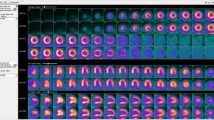Abstract
Clinically indicated radionuclide myocardial perfusion imaging most often is performed using single photon emission CT (SPECT). Its major strengths include an extensive knowledge base attesting to its diagnostic accuracy and ability to stratify risk of short-term events, and the wide availability of instrumentation. However, it is not accurate for detecting subclinical coronary artery disease (CAD), it can seriously underestimate CAD extent, and it performs better in patients who are able to exercise. Myocardial perfusion positron emission tomography (PET) is an option that is being increasingly used for more challenging patients, especially those who need to be stressed pharmacologically. The current evidence base is small, with most work concentrated on exploring how PET data may expand the field of nuclear cardiology, rather than comparing it with SPECT. A few capabilities unique to PET include potential of routine quantitation of myocardial blood flow, assessment of peak stress rather than post-stress left ventricular function, and superior compensation for scattered counts.
Similar content being viewed by others
References and Recommended Reading
Bateman TM, Heller GV, McGhie AI, et al.: Diagnostic accuracy of rest/stress ECG-gated Rb-82 myocardial perfusion PET: comparison with ECG-gated Tc-99m sestamibi SPECT. J Nucl Cardiol 2006, 13:24–33.
Sampson UK, Dorbala S, Limaye A, et al.: Diagnostic accuracy of rubidium-82 myocardial perfusion imaging with hybrid positron emission tomography/computed tomography in the detection of coronary artery disease. J Am Coll Cardiol 2007, 49:1052–1058.
Lertsburapa K, Ahlberg AW, Bateman TM, et al.: Independent and incremental prognostic value of left ventricular ejection fraction determined by stress gated rubidium 82 PET imaging in patients with known or suspected coronary artery disease. J Nucl Cardiol 2008, 15:745–753.
Yoshinaga K, Chow BJ, Williams K, et al.: What is the prognostic value of myocardial perfusion imaging using rubidium-82 positron emission tomography? J Am Coll Cardiol 2006, 48:1029–1039.
Dorbala S, Vangala D, Sampson U, et al.: Value of vasodilator left ventricular ejection fraction reserve in evaluating the magnitude of myocardium at risk and the extent of angiographic coronary artery disease: a 82Rb PET/CT study. J Nucl Med 2007, 48:349–358.
Bateman TM, Cullom SJ, Volker LL, et al.: Transient ischemic dilation in response to dipyridamole stress with rubidium-82 myocardial perfusion PET: quantitative compassion of low-likelihood and CAD populations. J Nucl Med 2007, 48:106P.
Lortie M, Beanlands RS, Yoshinaga K, et al.: Quantification of myocardial blood flow with 82Rb dynamic PET imaging. Eur J Nucl Med Mol Imaging 2007, 34:1765–1774.
deKemp RA, Yoshinaga K, Beanlands RS: Will 3-dimensional PET-CT enable the routine quantification of myocardial blood flow? J Nucl Cardiol 2007, 14:380–397.
Anagnostopoulos C, Almonacid A, El Fakhri G, et al.: Quantitative relationship between coronary vasodilator reserve assessed by 82Rb PET imaging and coronary artery stenosis severity. Eur J Nucl Med Mol Imaging 2008, 35:1593–1601.
Parkash R, deKemp RA, Ruddy TD, et al.: Potential utility of rubidium 82 PET quantification in patients with 3-vessel coronary artery disease. J Nucl Cardiol 2004, 11:440–449.
Ling MC, Ruddy TD, deKemp RA, et al.: Early effects of statin therapy on endothelial function and microvascular reactivity in patients with coronary artery disease. Am Heart J 2005, 149:1137.
Wielepp P, Baller D, Gleichmann U, et al.: Beneficial effects of atorvastatin on myocardial regions with initially low vasodilatory capacity at various stages of coronary artery disease. Eur J Nucl Med Mol Imaging 2005, 32:1371–1377.
Sdringola S, Gould KL, Zamarka LG, et al.: A 6 month randomized, double blind, placebo controlled, multi-center trial of high dose atorvastatin on myocardial perfusion abnormalities by positron emission tomography in coronary artery disease. Am Heart J 2008, 155:245–253.
Preiss D, Sattar N: Lipids, lipid modifying agents and cardiovascular risk: a review of the evidence. Clin Endocrinol (Oxf) 2008 Dec 3 (Epub ahead of print).
Schenker MP, Dorbala S, Hong EC, et al.: Interrelation of coronary calcification, myocardial ischemia, and outcomes in patients with intermediate likelihood of coronary artery disease: a combined positron emission tomography/computed tomography study. Circulation 2008, 117:1693–1700.
Markiewicz R, Bybee KA, McGhie AI, et al.: Diagnostic benefit of combined coronary calcium and perfusion assessment in patients undergoing PET/CT myocardial perfusion stress imaging. J Nucl Cardiol 2008, 15:S36.
Greenland P, LaBree L, Azen SP, et al.: Coronary artery calcium score combined with Framingham score for risk prediction in asymptomatic individuals. JAMA 2004, 291:210–215.
Schenker MP, Dorbala S, Hong EC, et al.: Interrelation of coronary calcification, myocardial ischemia, and outcomes in patients with intermediate likelihood of coronary artery disease: a combined positron emission tomography/computed tomography study. Circulation 2008, 117:1693–1700.
Zhang Z, Machac J, Helft G, et al.: Non-invasive imaging of atherosclerotic plaque macrophage in a rabbit model with F-18 FDG PET: a histopathological correlation. BMC Nucl Med 2006, 6:3.
Rudd JH, Myers KS, Bansilal S, et al.: (18)Fluorodeoxyglucose positron emission tomography imaging of atherosclerotic plaque inflammation is highly reproducible: implications for atherosclerosis therapy trials. J Am Coll Cardiol 2007, 50:892–896.
Rudd JH, Myers KS, Bansilal S, et al.: Atherosclerosis inflammation imaging with 18F-FDG PET: carotid, iliac, and femoral uptake reproducibility, quantification methods, and recommendations. J Nucl Med 2008, 49:871–878.
Tahara N, Kai H, Yamagishi S, et al.: Vascular inflammation evaluated by [18F]-fluorodeoxyglucose positron emission tomography is associated with the metabolic syndrome. J Am Coll Cardiol 2007, 49:1533–1539.
Author information
Authors and Affiliations
Corresponding author
Rights and permissions
About this article
Cite this article
Hsu, BL., Bybee, K.A. & Bateman, T.M. Positron emission tomography myocardial perfusion imaging for the detection of atherosclerosis. curr cardiovasc imaging rep 2, 176–182 (2009). https://doi.org/10.1007/s12410-009-0022-9
Published:
Issue Date:
DOI: https://doi.org/10.1007/s12410-009-0022-9




